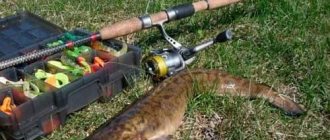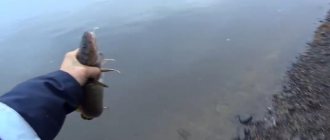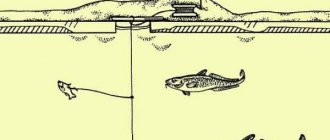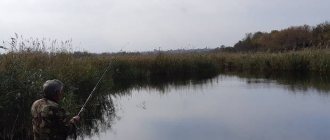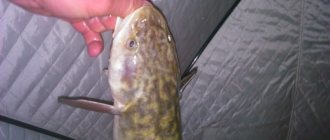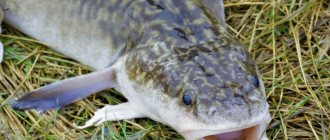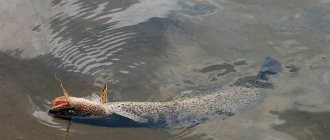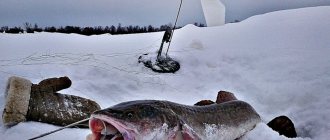Tackle design
Zakidushka is the first bottom tackle invented by man.
What’s easier is to tie some thread to a piece of stick, acting as a working fishing line, and equip it with a sinker and hooks. Modern gear is mounted almost the same way as in the old days. A do-it-yourself burbot bait is made in the following sequence:
- A reel measuring from 30 to 50 centimeters in length is cut out of wood, plastic or any other suitable material.
- Recesses are cut out from the ends for winding the fishing line.
- One end of such a cut from the bottom is made long so that the tackle can be stuck into the coastal soil.
- Up to fifty meters of thick, 0.25-0.3 mm in diameter, monofilament nylon fishing line is wound onto the reel.
- A sinker and a hook are mounted on the fishing line. The weight of the load is selected taking into account the strength of the current in a particular body of water.
- The equipment is made sliding, this is the so-called inline, when the fishing line passes inside the sinker.
- Below it, a protective silicone damper is placed and a swivel is tied.
- A leash made of fishing line 0.2-0.25 mm thick and a hook suitable for the selected bait are attached to the swivel.
The second equipment option is the familiar paternoster. Here is the sequence of its mating:
- At the end of the working line we make a loop approximately 60 centimeters long.
- We cut it in a ratio of 2:1 (to get shoulders of 40 and 20 centimeters).
- We tie a sinker to the short arm of the rig, and a leash to the long arm. If a thin fishing line, 0.25-0.28 mm, is used as the main line, the hook can be attached directly to it.
Currently, reel-based fishing rods are increasingly being replaced by spinning rod-based fishing rods. Of course, these fishing rods are more convenient for fishing, but their production is more expensive, and transportation to the fishing spot requires more space in the car. While simple supplies can fit about two dozen in a simple backpack.
Lures used
The predatory tendencies of burbot suggest the use of animal baits when catching it. The following are used as such:
- fish fry: ruffe, gudgeon, bleak, roach, crucian carp and others;
- fish slices with pieces of skin for better attachment to the hook;
- baby frogs;
- various worms: preference is given to crawling worms;
- pieces of seafood;
- shellfish
Fishing principles
- It is worth going out for burbot from the end of summer until the onset of freeze-up. The cod brother originally comes from northern waters, so in warm summer water its activity is close to zero and only when it gets colder does it begin to feed.
- Many anglers note that the worse the weather for the fisherman, the better for the burbot. Indeed, with low pressure, accompanied by light rain and wind, this predator takes on more confidently.
- As for the time of day, the best time to catch burbot is from evening to midnight. It is at this time that the predator rises from the depths of the river bed to the shore, where it hopes to profit from prey. This, in turn, made it possible to catch him with tricks.
Fishing places
The most effective burbot fishing occurs in the following areas:
- sections of the river with a hard sandy or pebble bottom;
- places near cliffs and steep ridges;
- at the entrance and exit from pits;
- local irregularities of the river bottom;
- under overhanging trees;
- near the snag.
It should be especially noted that it is impossible to find burbot on a muddy bottom or in areas with aquatic vegetation, so such places for sneak fishing are unpromising.
Tactics
- Placement of snacks in the chosen place is done in advance before dark. Depending on the strength of the river current, gear is placed at intervals of five to ten meters.
- Before casting, the required amount of fishing line is removed from the reel, laying it out in rings on a clean bank; if the area is grassy, some kind of fabric is laid out under the coils of monofilament: burlap, a raincoat or something similar. Then they take the sinker in their hands or hold the tackle by the fishing line, and, taking aim, throw it into the water, having previously equipped it with bait.
- Sound and light alarms are attached to installed fishing rods. In order to monitor bites, various types of flashlights are used, and fires are also lit, the light from which, according to experienced fishermen, can additionally attract burbot.
- The triggered alarm will tell you that a fish is on the hook. Burbot takes the bait greedily, the hook rarely jumps out of the mouth, so fishing is carried out forcefully, without ceremony. Just in case, you should always have a landing net at hand - an assistant when fighting a particularly large trophy.
Tactics and fishing techniques
Check the weather forecast before fishing. Burbot loves not just cold water, but bad weather. Rain and wind are ideal conditions for catching spotted barbel. This is not very pleasant for fishermen, so you need to stock up on warm and waterproof clothing. A fire on the shore would be appropriate, especially since burbot is completely indifferent to light, since it hunts mainly using the sense of smell.
[THERE IS AN ANSWER] How to catch burbot from ice
The location of the hooks on the bank should be such that they cover as much of the river as possible, but at the same time the fisherman does not have to make long runs from one to the other. This is achieved through different casting lengths and directions. In this case, it is necessary to take into account the speed of the current, the depth, and remember them well, otherwise at night when fishing or re-casting, you can confuse all the gear.
Baits
Mainly live baits:
- worms (crawl, red dung). It is better to have a large bunch that will cut off other types of fish;
- live bait: ruffe, gudgeon, crucian carp or other small fish living in a given reservoir;
- frogs; pieces of fish.
Casting technique
Too much range is rarely required, so the tackle is usually thrown by hand. The required length of fishing line is laid in circles on the shore. The reel is firmly secured. The sinker swings or unwinds and is thrown to the desired location. The fishing line is stretched and a bite alarm is hung on it. The next hook is installed nearby so that the gear does not get mixed up.
Having determined the fishing location, the fisherman prepares the coastline for comfortable casting of gear and unhindered landing of the caught fish. To do this, in the area where the plant is installed, the grass is crushed and the approach to the water is cleared of thickets.
Artificial baits for spinning rods
When using a spinning rod for fishing, you need to take care of artificial baits. The ideal option would be jigs: foam fish and silicone baits. Also, in some places, the predator can respond well to submersible wobblers and spoons.
Silicone baits include vibrotails and twisters with active play in the water. Dimensions must be selected depending on the size of the fish that will be fished.
Expert opinion
Smirnov Alexander Stanislavovich
Wilderness survival instructor. More than 15 years of teaching experience
Usually 7-10 cm are used. Larger ones can be used to catch trophy burbot. This is interesting: How to make a knife for hunting with your own hands at home
The so-called “edible” silicone is especially popular. It is recommended to choose ones with the aroma of fish, worms and shrimp.
Rice. 2. Nozzles in the form of crayfish and frogs also show good results.
Methods for catching burbot
Today we will talk about the two most common methods of catching burbot from ice:
- on zherlitsy, postavushki, “poke”. There are many names - the essence is the same!
- in a plumb line to the “snitch”. A special jig with a fish bait, which is tapped on the bottom, thereby attracting fish.
Zherlitsa (supply)
We will not mention the design of the vent itself in this article. There are a lot of them and each angler can choose the one he likes best. Beginner fishermen can buy a ready-made girder in a store, equip it correctly - and this will not be the worst option. Burbot is so unpretentious to the quality of tackle that it can be caught simply on a rope with a nylon leash and a hook, as they did in the villages. This hunter has poor eyesight, but his sense of smell is good. When searching for prey, it primarily focuses on the smell and lateral line, and only then on the organs of vision.
I repeat, the thickness of the line and the delicacy of the tackle for burbot are of secondary importance, so I suggest using a main line with a diameter of 0.4 mm and a leash of 0.3. They are necessarily connected to each other by a swivel and a clasp, into which a sliding weight, like an “olive,” rests, sliding freely along the fishing line. We select the weight of the sinker depending on the conditions: depth and current from 50 to 200 grams. The hook is a medium-sized double, it is better to select it based on the size of the live bait you caught. In our Ob realities, I would recommend using a soft tungsten leash so that the pike does not feed on your live bait with too much impunity. In addition, the leash simplifies the installation of live bait with a hook. An important point should be taken into account when equipping the vent - the nozzle should be located near the very bottom!
I recommend rigging live bait as follows. We push the leash through the mouth, bring it out behind the gill cover and thread the double into the loop of the leash, hooking it behind the back of the fry. No knots, simple and works great. Especially in the current, the fry stands with its head in the current, so it is easier for it to remain active longer, experiencing less water resistance. There are different ways to attach live bait, you can familiarize yourself with them in our article and choose the one that suits you best.
The load should lie on the bottom, and not float in the water column - burbot is a bottom predator. After a bite, he usually swallows the bait very deeply. You can also use a large single hook, this will make it easier to remove it from the voracious mouth. I like the double rig, and if the burbot is swallowed too deep, I just unfasten the leash from the clasp and put on a new one. I recommend that novice fishermen use only one leash - this will prevent tangling and snagging on the hole when fishing.
Another interesting way of rigging, definitely worthy of attention, you can watch in this video:
Fishing with a “snitch”
The most effective fishing tactics will be to combine these two fishing methods. I loaded several baits with fry and sat next to me in the tent so that it wouldn’t get boring, playing with the bait in a plumb line.
The squealer came from the banks of the Yenisei, although this is not certain. The essence of the gear is simple - a powerful fishing rod, often just a baton stick (which also performs pacifying functions), a thick fishing line, at the end of a large jig-spoon (pictured) on the hook of which a piece of live bait is hung. The fishing technique is not complicated. We throw the bait several times near the bottom, lower it sharply, creating a knock and raising the mud from the bottom, and take pauses.
If you are unable to make such a spoon yourself, and there is nowhere to buy it (which is most likely), you can replace it with a heavy jig head. To extract more noise, it is recommended to hang small petals from rotating spinners through the winding ring. Noise play is one of the main factors attracting “blind” burbot.
Fishing with a line
We will not promote and teach how to catch burbot in this not entirely sporting way. It is allowed to use no more than 10 hooks per person, otherwise the net will be considered poaching gear. Let's leave this productive, but more tedious method of fishing to local village fishermen, for whom it is acceptable.
Features of winter fishing for burbot using girders
Winter fishing for river predators turns out to be an interesting and profitable activity. For successful fishing, it is important to choose the right place, set up a trap with bait and wait. It can be difficult to do this on an unfamiliar body of water, but it is possible. It is best to use live bait as bait, because the bait must move actively.
What does the tackle consist of?
A fishing rod for catching burbot in winter can be made in a few minutes. To do this, you need to take a wooden stick slightly longer than the diameter of the hole. Tie a slingshot to it with a fishing line wound around it. The length of the fishing line depends on many reasons, but it should be at least 10 m. At the end of it there is a hook with live bait. The predator catches the bait, the line unwinds, and the burbot puts itself on the hook.
Catching predators is not always done with ordinary girders. You can build a bun. It consists of the same stick, which is laid across the hole. A reel with a piece of fishing line is tied to it. There is a split in it for fixing the fishing line.
When biting, the line is freed from the split and the fish is placed on the hook. The reel used to be made of wood, today you can use a plastic bottle. It can have different sizes. The main thing is to fulfill your functions. Such a structure can be kept on the hole all winter.
The poke is done a little differently. A fishing line about 2 m long is tied to a pole, which is stuck into the bottom of the reservoir. The fishing line is equipped with a sinker and a hook on which the bait is attached. Kolobashka and poke are often used by fishermen who use permanent fishing spots.
It is recommended to tie a strong hook, with a sharp tip and a long shank. The weight of the sinker is chosen depending on the size of the live bait. The sinker should lie on the ground, occasionally rising above the bottom and falling back. The rising turbidity attracts burbot. It is enough to make a leash 50-60 cm long. The bait for fishing on such a leash actively moves, but does not float away anywhere.
Bait in the form of a loach, ruffe, or other small fish is placed behind the back. In their absence, fry of any breed, shrimp, and pieces of liver are added.
Choosing an installation location
The main winter fishing takes place when there is a lot of snow and severe frosts. When choosing a fishing spot on an unfamiliar body of water, you have to drill many holes in order to install more girders with equipment. Some areas have gear restrictions, so you need to know this in advance.
An ice hole with a successful bite should be located above a path or other place where predators gather. If you first measure the depth, then the fishing line needs to be fixed. The holes are drilled at a distance of several meters from each other. They can be placed 10-20 m apart in a checkerboard pattern, in the form of a semicircle, a straight line and in other ways.
Burbot loves depth, especially in winter frosts. Catching it with a bait is an effective way of hunting. He moves along the same paths. Their width is about 1 m. Finding trails means providing yourself with fish for many years.
Drilling holes and installing vents
The burbot bite lasts all winter. Burbot spawns in December and January. During this period, he briefly refuses to eat. The spawning period depends on weather conditions and the nature of the reservoir. When the water warms and its temperature reaches +10˚С, hunting for burbot in winter temporarily stops. It hibernates until frost sets in.
To install the girders, it is necessary to drill many holes in the ice. They are arranged in a zigzag or straight line, in an arc or in a checkerboard pattern. The choice of scheme depends on the location of the fish sites and the bottom topography. A hole in the right place can produce a good catch. There is no point in using other holes in the ice. It is best to cover the ice hole with the ice hole installed with a piece of polystyrene foam or prepare an ice pick for cutting through ice.
Tackle design
The zakidushka is considered one of the lightest gear specialized for fishing from the bottom. It involves a fairly thick fishing line, at the end of which a sinker is attached, and in addition a single or row of leashes with hooks (some fishermen use more than 10, but this is not always advisable, not to mention the lack of sportiness of this kind of gear).
This entire system, in the best case, is wound on a reel, in the worst case, simply on a wooden stick. The lightness of the system has a cost-effective effect on prices - the fishing line and hooks stand up relatively little, and numerous fishermen produce sinkers for donks and hooks without the help of others.
Numerous fishermen also use various bite alarms, most of all these are bells of different systems. Burbot tackle, due to its low price, and therefore the ability to use at the same time a huge number of tackles, makes it possible to quickly find fish, including in an unknown body of water.
Thus, the gear for night fishing for burbot on the river. This simplest donk is called a zakidushka. Most likely, the name is associated with the casting method, in which case it is available - without the assistance of a rod, in a cast, with your hands. The tackle consists of a reel with the main line, a solid sinker and a leash with a hook on top of it. As a rule, heavy lead weights are used, cast in a tablespoon or a figure of approximately the same condition.
For spring fishing, I use even the heaviest sinkers weighing at least 400-500 grams. Very fast spring current. I hollowed out the configuration in sand-lime brick. It is quite rigid, as are the products subsequently cast in it, but without exception, these burrs can only help to hold back loads on the river flow. However, in the autumn, a spoon is enough, if, obviously, there were no long rainfalls, and the river did not rise in the autumn flood.
Catching burbot on a girder (set) in winter
Recently, anglers have become less and less likely to use girders for catching burbot. This is most likely due not to the complexity of this type of winter fishing, but to the increase in the number of dishonest... wheatgrass. The installed gear has to be left at least overnight and monitored all the time - not an easy task. But, nevertheless, a dozen stationary supplies can easily provide fresh burbot all winter.
I use the girder mainly at the beginning of winter. When the ice has already frozen, the burbot begins to fill its paths. To successfully fish with a snitch, so as not to freeze once again, you just need to know where the fish go and concentrate. Everything is simple here. Temporary supplies do not require any special skills.
“Snitch” tackle for burbot in winter
For active burbot fishing in winter, a design called a “snitch” is used. For those who didn’t know, burbot, having not very good eyesight, responds perfectly to sound stimuli and the smell of bait.
The tackle works both day and night. However, according to many experienced fishermen, the catches are more substantial in the evening twilight. Fishing is carried out in explored places, in which 100% there is burbot.
Fishing is more productive in reservoirs with a rocky or sandy bottom. Silt reduces the sound intensity when you tap the bait on the bottom. It is the knock that attracts burbot in this type of fishing. The burbot hears the blows of the bait on such a bottom from afar and hurries towards the roar.
To enhance the peculiar “ringing” that is attractive to burbot, you can attach auxiliary noise sources to the bait. Tee hooks, rings are suitable for this... When the bait hits the ground, these objects make sounds that initiate the burbot hunt.
Taking into account the fact that in this type of fishing medium and large burbots are most often taken, the minimum thickness of the fishing line should be 0.3 mm.
To catch burbot in winter, you need to prepare special gear. They are specific, but simple; they are quite easy to make with your own hands. Burbot is caught in winter using both active types of gear and passive ones. All winter gear for burbot must be sufficiently strong and reliable.
Lure fishing
The gear for winter fishing for burbot with a spinner is no different from the snitch already described above, except, in fact, the bait itself. In winter, you can use the entire arsenal of winter baits for predators. But it’s still better to use special baits for burbot. Many anglers practice fishing with a balance beam, and this is completely justified. Jigs, finders, nails - all this can be successfully used.
A jig head bait with a piece of fish will also work. After all, we already know that the main thing is to find a place, bait and tackle are secondary. This predator also takes advantage of silicone. If the burbot is active, feeding, and in principle is in this place, it will grab any bait. Therefore, as an experiment, you can try fishing in winter with a jig head (as a snitch).
Animal replanting
Almost all artificial baits for burbot must be baited with something edible. The best bait for burbot in winter is fish or pieces of fish. Many fishermen actively use store-bought sprat or capelin, especially when they don’t want to bother with catching live bait. The same baits are also used when fishing with a donk. This method is more applicable for strong currents, when it is necessary to use a heavy sinker in the rig.
- The debate about the freshness of the bait continues. Some anglers claim that the fish take well on missing baits with a scent, others say that they are caught exclusively on fresh baits. The tastes of fish from different bodies of water differ.
- Burbot is not always active. If you are in a place you know where it is definitely there, and the bite is weak, you can use feeding to provoke the predator to hunt. This fish has an excellent sense of smell.
- Bait for burbot, accordingly, must correspond to the preferences of the object of hunting, and be of animal origin - remains of fish, liver, minced meat. All this can simply be mixed in water and poured into the hole. Or throw in pieces of fish, leftover shrimp, etc. The preferences of fish in a particular body of water can only be determined experimentally.
We invite you to read: Heating a greenhouse in winter - cheap and economical methods, photos and videos, the price of greenhouses with heating and where to buy in Moscow and St. Petersburg
It is well known that fishing for this fish in December is the most effective. At this time, pre-spawning zhor is observed. With the onset of cold weather it begins and continues until spawning. Burbot is the most active and hungry in December. But this does not mean that the rest of the time it is poorly caught. After spawning, this fish consistently bites the entire ice cover until warming occurs.
As the ice melts, its bite gradually subsides. Then this northerner hides in the most remote places and waits out the warm season there. But this does not mean that he is not active at all. In inclement, cool weather, he may crawl out of his den for a short feeding to pass the time until autumn.
Author of the article: Kamyshanov Andrey.
Experienced amateur fisherman. Popularizer of amateur fishing and practices. With a fishing rod in hand from an early age. Founder and author of the fishing websites Podlednik.ru and Rybafan.ru, as well as the YouTube channel RYBAFAN
Baits and baits for autumn fishing for burbot
Bait for burbot in the fall should be exclusively of animal origin. The predator neglects any plant odors, completely refusing to attack them.
Bait for burbot in the fall should be of exclusively animal origin.
What to use to catch burbot in the fall:
- standard animal bait: bloodworms, large worms, maggots, crawling worms;
- various live baits: gudgeon, ruff, char, perch, roach, loach, perch and other small fish. We recommend baiting the bait by the upper lip or piercing it under the dorsal fin, this will ensure the mobility of the bait. There are other methods of baiting, one of the best options is to pass the hook and line through the mouth and pull it through the gills. If you have a choice, it is better to take the most common fish in the reservoir, usually a gudgeon. The advantage of the ruff is its strong aroma that attracts burbot;
- the easiest bait to obtain is chopped fish or chicken offal;
- Another common bait for catching predators, which is found in all bodies of water, is frogs.
Read more
How to catch ruff?
The classic method of hunting burbot does not require the use of bait, because the bait itself is quite aromatic and attractive. Many fishermen claim that feeding the area is beneficial. It is better to make bait from clay or earth with the addition of maggots, worms or similar components. We put them in a feeder (if a feeder is used) or roll them into balls and throw them to the fishing spot. A simpler and no less effective option is to throw in minced meat, pieces of fish, chicken offal, etc.
Snack for burbot
On many rivers they are already catching spawned burbot, and not only from the ice. Somewhere rivers do not freeze in some places all winter, somewhere fishing takes place on canals. Despite the primitiveness of burbot fishing, there are quite a lot of adherents of this night fishing. First of all, this is due to the very romance of the night, when fast water gurgles among the snowy shores, moonlight floods everything around and shines silver on the ice edge. But the gastronomic qualities of freshly caught burbot are incomparable. The white and large burbot liver is especially tasty and tender. You can't buy fish like this anywhere. Only the fisherman has the opportunity to taste it (you can read about preparing burbot in the “Fisherman’s Cuisine” section).
Snack for burbot
The burbot bait is probably the simplest of all bottom tackles. And most often it is she who closes fishing in the fall and opens it in the spring, since she takes burbot in the coldest water. In the spring, ide, bream, and roach are just getting ready to rise to the upper reaches of rivers to spawn. And the burbot fish is right there...
As already mentioned, the basis of the tackle is a heavy sinker weighing at least two hundred grams. In some places it is heavier, but in others there is a sufficient weight weighing a little more than a hundred grams. It all depends on where the tackle will be thrown and what kind of current there is.
The fishing line used for casting is monofilament, thick, with a diameter of 0.5-0.6 mm. Firstly, so that when casting it does not slip out of your fingers. And secondly, burbot does not care about its thickness, since fishing takes place in the dark. In addition, at night such a fishing line is better visible on the coastal sand with the light of a flashlight. It doesn’t hurt to make a knot on the main line above the leash, since even a thick line can slip out with a strong casting jerk, since it is often wet.
For leashes, you can use monofilament fishing line with a diameter of 0.3-0.35 mm. The leash is tied above the sinker about 10-12 cm. Burbot takes only from the bottom. To avoid confusion, especially in the dark, and to avoid getting hooked yourself, it is better to use one leash about 30 cm long. Night fishing virtuosos, like my father, manage to use three leashes, but I think this is unnecessary.
A supply of main line about 50 meters long is wound on a plastic reel. Plywood ones warp from water, and store-bought trinkets break. It is better to cut out the reels yourself from durable plastic.
The hooks used are large, with a long shank, since they have to be pulled out of the strong burbot mouth. It’s better to fasten the leashes to the fasteners on the main line. This will allow you not to dig into the throat of the caught fish, but simply unfasten the leash and put a spare one.
Baits for catching burbot
You can use worms, live and cut fish as bait, but I noticed that in the spring a large cluster of worms attracts burbot more than fish, and in the fall large burbots are more often taken for cutting or live bait. However, it may be different in different places.
Installation of a snack
Snack tackles are also easy to install. The main fishing line in the form of rings is laid on a gentle bank, which is usually a sand spit, washed up and smoothed by the current, and opposite it, as a rule, is located on the opposite side a high bank with a cliff. A deep pool with driftwood at the bottom swirls beneath him.
It is advisable to re-sort the main fishing line lying in rings on the sand, only now in the opposite direction. This way the line will go into the water without tangles or loops after casting.
The reel with the remaining main line is simply stuck into the sand. It is for this reason that it is advisable to use a reel, not a purchased plastic one, which is not enough for one fishing trip, but a homemade one, made from a solid board or durable plastic.
Now all that remains is to make the cast. For this purpose, the sinker is swung in a pendulum manner on the fishing line and then sent into the water with a strong push, carefully monitoring so that the hooks do not catch on clothing and the body. After casting, the line must be secured in the split tip of a willow rod and a ringing bell must be hung on the line with a simple tightening loop. You can attach a bell from the feeder to the flexible tip of the rod.
After all these operations, all that remains is to wait by the crackling hot fire for the bell to ring, which means for the bite of the night predator. To comfortably remove prey and attach worms, you need a large hand-held flashlight that can be placed at the trench, and a headlamp is a must. It will shine exactly in the direction the angler is looking.
How to catch burbot with a hook
Burbot is a night hunter. Therefore, if you are planning to fish with hooks, then it is better to come to the shore one and a half to two hours before dark. He will begin to peck no earlier than an hour after sunset. The biting continues until about 12-1 am, then, as a rule, it stops.
Most fishermen leave their bait on the shore all night. However, leaving them unattended, you need to limit the free movement of the caught burbot as much as possible. The fact is that if there is too much free play on the fishing line, and a small load, then the burbot will go to the nearest snag and there will tear off your tackle along with the bait and leash.
When casting relatively close, there is no need to use a fishing line. Moreover, in the cold it hardens, which makes re-casting difficult. Therefore, monofilament with a diameter of 0.3 mm is used more often and more successfully. For leashes whose length is from 20 to 30 cm, a fishing line of 0.4−0.6 mm is suitable.
Where to fish?
In most regions of Russia, the conventional spawning period for burbot is considered to be from December 15 to January 15. On these days, there is a ban on fishing in water bodies. It’s worth checking the timing before going fishing. They may vary by region.
The main places for catching burbot in winter on a river or lake, streams and other bodies of water in Russia are well known. You won’t have to look for them for long, especially if you take into account the recommendations of experienced fishermen who are well aware of the traditional habitats where fish can be found.
Several habitats of burbot can be distinguished.
- Volga and its tributaries. Burbot is not very common in this river, but it can be found in the Rybinsk Reservoir.
- Ural region. In Vyatka and the Urals in general, burbot fishing is quite popular. It is mined in the Chusovaya River natural park, in the Nitsa River.
- Siberia. Here burbot is found on the Yenisei, on the Ob; it is widespread, since the cold and stormy waters of local rivers provide it with the necessary conditions for a comfortable year-round habitat. It is also found on the Lena, as well as in the waters of the Amur.
- Altai. Here the fish is found on the Irtysh, which originates in the eastern part of the mountains.
- Leningrad region. Here burbot can be found in the Neva basin, in the Gulf of Finland, but you definitely shouldn’t count on a record catch. Larger specimens are found in Pasha and Vuoksa, in the vicinity of Sukhodolsky in the Priozersky district of the region.
- Moscow region. Burbot is not very widespread here. It can be found in the Klyazma River, in Sherna. Near Dubna in the Volga, fishing is also possible, but not closer than 1 km from the dam. On the Oka, fish are caught near platform 107 km, as well as in its tributary Sknizhka.
Active elastic band
In the first case, you should play with bait, imitating a fry. By using the stretches and pauses that the elastic allows you to do, you provoke the predator to bite. In this case, various decoy baits are mounted on the hooks. They started with the semblance of twisters cut from rubber gloves, “cigarettes” - foam plastic in the shape of an elongated fish, shiny sparkles made from nickel-plated antennas, or simply equipped the doubles with “Campbrick” - insulation from wires and red thread. Afterwards, more and more often, fishermen began to replace home-made baits with ordinary twisters. It was in vain that the “cigarettes” were forgotten, which played interestingly in the water, floating up during a pause, and the “cambrics” were quite catchy.
The active method is very catchy, and comes to the fore from the beginning of June, when the pike perch has spawned and begins to feed. The whitebait is growing up, and the perch is going on a massive hunt. Pike can also be caught well this way. When fishing for it, you should make leashes from thick fluorocarbon, or, in extreme cases, use steel ones. The use of steel leashes is not recommended, because the game of bait changes. It becomes more enslaved and less interesting, keep this in mind.
The “rubber band” must be installed at a moderate current. In standing water, the tackle does not open fully and does not play properly. In addition, fish in still water attack the bait more selectively. During the current this happens much more aggressively and willingly.
To install gear on a predator, choose sandy or pebbly soils. Exits to spits, places where a reverse current forms, entrances and exits from pits, especially near which there are snags, work well.
When catching night pike perch and perch, also pay attention to the riffles, where it goes out at dusk to feed, and the pool behind them
How to arrange the bins correctly
As I already said, catching burbot using bait takes place in the dark. Even with a flashlight and warmly dressed, you don’t want to wander away from the fire again. So we need to set up camp sites in such a way that we can shorten our walks and work out the entire coastline near the camp if possible.
The course of the burbot is still unknown. He can take near the shore, or he can move far from it. It turns out that three placed traps guard the burbot in a square of 20 by 20 meters. Heavy weights make this easy to achieve.
The first cast is cast to the full length of the fishing line. Moving 6 - 7 meters away from it, the next one is installed, but part of the volume is already used - six meters less. The third is installed, if the shore is not very shallow, at a distance of 5 - 6 meters from the shore.
I think the meaning is clear. Thus, we cover a fairly good area with three zakidushki. If the burbot is walking, then it must smell one of the two baits.
A small nuance. When installing, the river current should be taken into account. Until the sinker falls to the bottom and settles there, the line drifts a little. Therefore, it is worth making the installation with this in mind. It’s very easy to get confused in your own little things in the dark.
The remaining gear is installed according to this scheme. When the job is done, the bells are attached - you can sit by the fire, sip some hot food, and admire nature.
We use skillful hands
Becoming the happy owner of this useful fishing device is very simple. You can, of course, go to the store and buy everything you need - there is no shortage of “noise” spinners on sale, for example, from the Finnish one. But the Russian “left-hander” knows how to do everything himself, and not only a master craftsman, but also any person can make it on his own - you just need a little patience and, in fact, imagine how to make a burbot snitch. Now we will explain.
First the simplest option. We will need:
- a small sheet of brass;
- a few centimeters of wire;
- two (or more) large hooks;
- lead.
We take a thin - 0.5 - 1 mm sheet of brass. Why brass? In principle, you can take bronze or red copper - all these are so-called “singing metals” that can ring loudly - it is no coincidence that bells are made from them.
The size of our sheet can be taken to be 60 cm long and 40 cm wide. We bend the sheet exactly in the center to get something resembling a gable roof. We drill a hole through which we thread the wire in both directions, not forgetting to leave an eye at the top through which the snitch will be tied to the fishing line. Two large hooks are attached to the edges of the wire
It is important that the hook rings and the main part of the forend should remain exactly under the fold of our “gable roof”
After this, the product remains to be turned over and filled with lead, and at the end, processed with a file to clean off all the roughness.
Strictly speaking, that's all - you can use it. Sometimes a metal ring is also attached to the top of the eye (the easiest way is to use a winding ring). The meaning of this improvement is that, when hitting the side of the knocker, the ring additionally produces sounds that attract burbot. Then such tackle is called a “ring”.
Cartridge knockers
Of course, the snitch does not have to be triangular. It can be made oval or square, and more than two hooks can be attached. Here, as they say, there is room for imagination and skillful hands to run wild. The main thing is that when it falls, it makes as much noise as possible, which will attract the burbot and force it to swallow the bait. Photos of burbot snitches can be easily found on the Internet. You can also use a double spinner, also known as a “clanger” - the operating principle is the same: make noise and excite the fish.
The most original way to modify a burbot hook with your own hands was proposed by a fisherman from Lipetsk, Ruslan Ostapenko. He added a couple of cartridge casings to the design. I made an ordinary triangular knocker, but in front of it I threaded a 12-gauge brass sleeve, sawn in half, onto the fishing line, and placed a 32-gauge sleeve inside. The result is a three-stage design, which creates even more noise when hitting the bottom.
